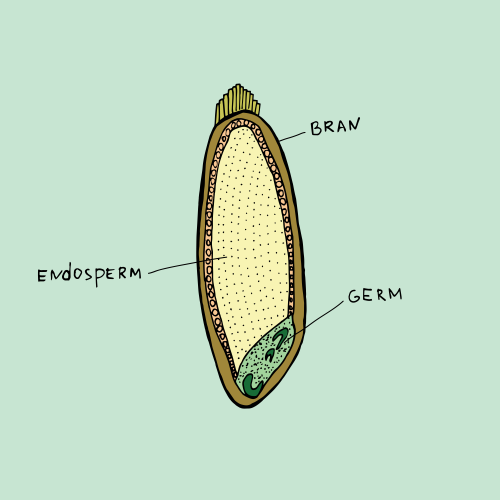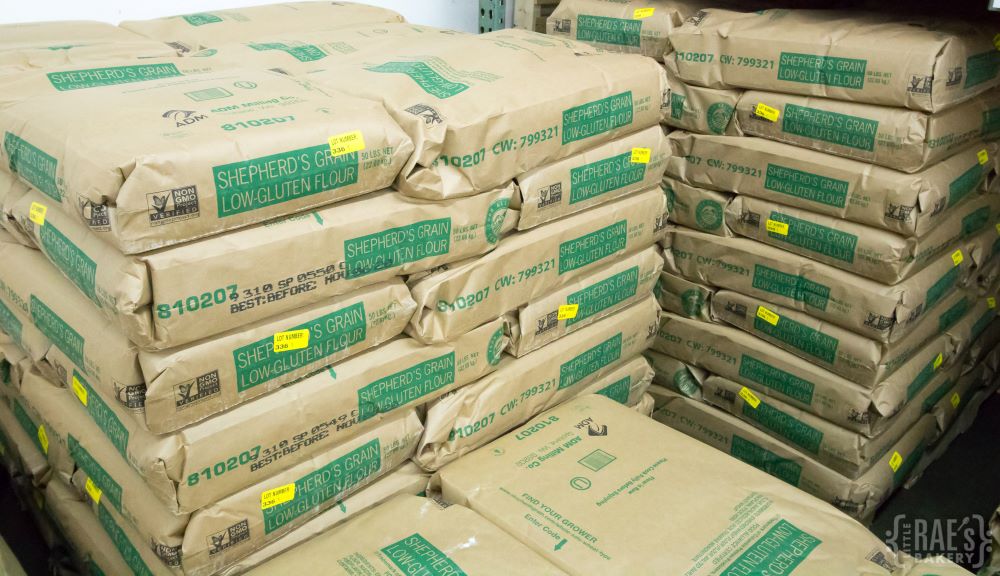Welcome back for Part 2 of our article series: This or That? How Ingredient Swaps Impact Your Recipes. Last time, we talked about different kinds of fat and how they impact the recipes they are used in. If you missed it, be sure to read it here. Up next: flours!
What’s in a Grain?
Most flours are a blend of different wheat crops with varying protein levels; this helps keep bags of flour consistent from year to year, even as different crops are harvested. Farmers harvest their grain and then evaluate the protein content and overall quality on site with high-tech systems. Based on the results, the grain is sold to mills, which convert it into flour with the desired protein content.
As part of the milling process, the grain is separated into its three main components: the bran, germ, and endosperm. The bran is the grain’s tougher outer layer, and it’s very high in fiber. The germ, rich in vitamins and nutrients, is the grain’s innermost layer. Finally, the endosperm is the middle layer making up most of the grain’s volume. It contains some nutrients, but not as many as the bran or germ.

The Flours
By mixing flour and water together in recipes, you are creating structure and elasticity to your baked goods. How much structure and elasticity you get depends on a couple of things. First, the wheat protein level in flour determines its ability to form gluten bonds (the more protein, the stronger the gluten bonds can be). Protein levels vary by type of flour as well as by .
Length and intensity of mixing also impacts gluten bonding strength, which is why overmixing can ruin the texture of your baked goods (ever seen the “do not overmix” warning or wonder why your delicate and airy cake turned into a piece of rubber? Overmixing could be to blame).
While most households tend to stock up on all-purpose flour, there are in reality a ton of flour options to choose from. Whether you are simply looking to refine your baking, you have an intolerance or allergy necessitating substitutes, or you want to know what can be subbed when you’re out of what a recipe calls for, we’re here to help! Read on to learn about some of the most common flour options, what they can be used for, and what they probably shouldn’t be used for.
All-Purpose Flour
All-purpose flour is the home baker’s go-to flour for a number of reasons. It’s easy to find at run-of-the-mill grocery stores, it’s shelf stable for up to 8 months (much longer than whole wheat flour), and its middling protein levels (10-13%) enable it to provide “good” results for most baked goods. All-purpose flour is made up of a mix of hard and soft wheat and includes only the endosperm—no bran or germ. However, because the endosperm isn’t very nutritionally rich, nutrients removed with the bran and germ are added back in later on in processing (this is called enrichment).
- Protein level: 10-13%
- What it’s good for: cookies, bread, waffles, pancakes, biscuits, pizza dough, pasta, muffins, pie crust… you name it!
- What it’s not recommended for: You can make most things with all-purpose flour and get a good result.
Cake Flour
Cake flour has the lowest protein content of the flours here—just 5-8%. This means it has less gluten, will result in a softer final texture, and will absorb lots of moisture and fat. It’s made from soft wheat only and is high in starch. The name really says it all: this flour is great for soft and light baked goods, and terrible for anything that needs structure, like breads.
- Protein level: 5-8%
- What it’s good for: cakes, muffins, biscuits, sponge cakes, pound cakes, angel food cakes, layer cakes.
- What it’s not recommended for: breads
Pastry Flour
Pastry flour can be white or whole wheat and typically has a protein level of 7.5-9.5%, making it the “in between” of all-purpose and cake flours. This flour is made from softer wheat, has a finer texture, and is high in starch. Despite the name, it works very well in a wide variety of baked goods requiring a softer texture.
- Protein level: 7.5%-9.5%
- What it’s good for: cookies, pound cakes, muffins, waffles, pancakes, scones, biscuits, pie crusts, tarts, bread sticks
- What it’s not recommended for: breads, angel food cake, anything that needs to be as light as possible in the end
Whole Wheat Flour
Whole wheat flour, unlike white flour, is made using all parts of the wheat grain—the bran, germ, and endosperm. Because of this, it has a high protein level (13-14%) and therefore a higher gluten content. This leads to stickier dough, less rise, and denser baked goods. The bran and germ in whole wheat flour make it more perishable than white flour, so it has a 3-month shelf life (vs. white flour’s 8). It’s high in fiber, making resulting baked goods more naturally nutritional than those made with white flour (which, as we mentioned, has had nutrients re-added through processing). If using whole wheat flour, we recommend letting your dough or batter rest for 10-30 minutes before baking to aid in moisture absorption.
- Protein level: 13-14%
- What it’s good for: cookies, breads, pancakes, pizza dough, pasta, waffles, scones
- What it’s not recommended for: cakes, light pastries
Self-Rising Flour
Self-rising flour is really a specialty flour (and one that you can easily make at home). Essentially, it is pastry flour that has already had leavening (rising) agents added—salt and baking powder. As such, it should only be used for recipes that specifically call for it—using it as a substitute in a recipe that calls for a different kind of flour will likely result in over-leavened baked goods. Picture muffins exploding over their cups and cakes that jump out of the pan while baking and onto the oven floor. Using self-rising flour in a yeasted recipe would be particularly disastrous. And while that might give you (or someone else) a good laugh, it’s probably not the final form you are looking for with your baking projects.
- Protein level: 8-9%
- What it’s good for: biscuits, recipes that specifically call for it
- What it’s not recommended for: yeasted breads, recipes that don’t call for it
Bread Flour
Bread flour typically has the highest level of protein (12-15%). It is high in gluten content (which makes sense, since a good bread needs gluten). It is made from a blend of hard wheat and a little barley flour.
- Protein level: 12-15%
- What it’s good for: artisan breads, yeast breads, some cookies, bagels, pretzels, pizza dough
- What it’s not recommended for cakes, croissants and other delicate pastries
Gluten-Free Flours
Making gluten-free baked goods isn’t our specialty, but there are a couple of things to know if you need to swap a flour with gluten for one without. First, there are some great brands that make blends meant to be easily substituted in recipes that call for all-purpose flour. Bob’s Red Mill is fairly accessible and has two varieties you can try: Gluten-Free 1:1 Baking Flour and Gluten-Free All-Purpose Flour. The 1:1 blend can be used for non-yeasted baked goods like cookies, cakes, brownies, muffins, etc. If you are making a yeasted recipe (like a bread), opt for the All-Purpose blend instead.
If you are trying out your own homemade blends at home, keep in mind that you may need to also add a gluten replacement, such as xanthan gum or guar gum, to give your baked goods the structure they would otherwise get from gluten. The general recommendation is 1 tsp of gluten substitute per cup of flour.
We use a variety of flours at Little Rae’s Bakery, but one thing that stays the same is who we purchase our flour from: Shepherd’s Grain. Shepherd’s Grain practices soil regenerating, no-till farming, resulting in premium flour that is not only healthier for consumers, but healthier for the environment as well. The company is also grower-owned; its flours are produced by family-owned farms, some of which have been working the same land for over 100 years.
Join us next time for the final part of this series focusing on different kinds of sugar. We’ll talk about how the sugar you choose impacts flavor, texture, and more. Sweet!

